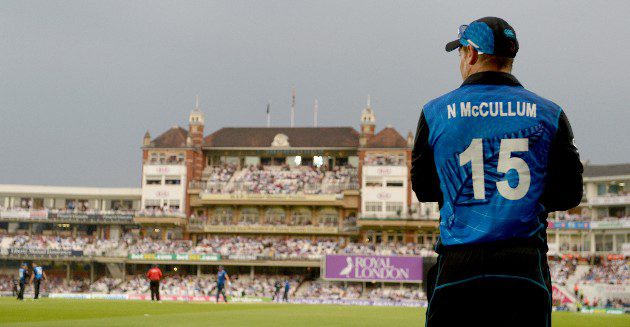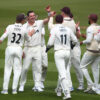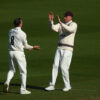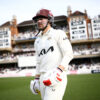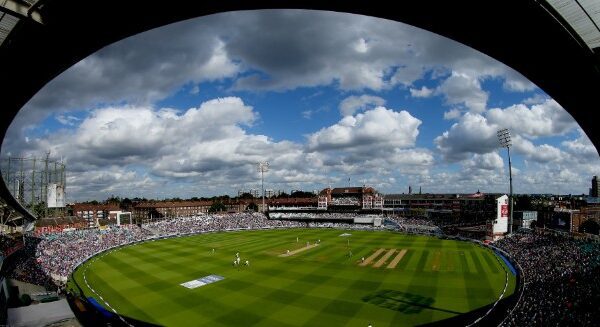When New Zealand arrive at the Kia Oval for Wednesday’s One Day International against England, it will be the latest visit in a series which stretches back 92 years. Richard Spiller looks back on their previous outings.
New Zealand were the fourth country to play England at The Oval – following Australia, South Africa and West Indies – when they made their Kennington debut in 1931. Matches have been sporadic over that time given they have often been one of two sides touring the country. So long in the shadow of their northern neighbours, the Kiwis traded on their underdog status for many years but anyone making that mistake nowadays should remember that they were desperately unlucky not to win the World Cup in 2019 – “by the barest of margins” in Ian Smith’s memorable phrase – and became the inaugural ICC World Test Champions in 2021.
Their first encounter with England at The Oval in 1931 proved a tough one, though. They had enjoyed an even share of honours at Lord’s but lasted just three days south of the river. Centuries from Herbert Sutcliffe, Duleepsinhji and Wally Hammond meant skipper Douglas Jardine (of Surrey) only batted for a few minutes in making seven not out before declaring at 416-4 on day two.
The tourists were rushed out for 193 before the end of the day, captain Tom Lowry (62) and Jack Kerr (34) saving them from complete capitulation, Middlesex paceman Gubby Allen claiming 5-14 in 13 overs.
Sent in again by Jardine, New Zealand did marginally better this time, Giff Vivian’s 51 their best, Maurice Tate claiming 3-22 and leg-spinner Ian Peebles taking 4-63 to overshadow the debut of slow left-armer Hedley Verity, who would become a Yorkshire and England great. He was one of two players getting a first look, the other Surrey’s Freddie Brown.
A 1-0 defeat in that series was echoed six years later, the Kiwis already behind when they reached The Oval. The tourists were 20-0 in the half-hour of play allowed on the rain-wrecked opening day, extending that to 249 all out on the second against an attack led by Surrey’s Alf Gover and Northamptonshire’s Austin Matthews. The latter was a surprise choice and he would become one of the early members of the one cap wonders club, the scalp of Walter Hadlee in each innings doing him little good.
England’s 254-7dec was built around 103 from Joe Hardstaff of Nottinghamshire, assisted mostly by debutant Denis Compton (65) and Hammond (31). Vivian’s 57 ensured the Kiwis made it to 187 all out in the second innings and, although the hosts needed 183, there was only time for them to finish on 31-1.
It was a dozen years – which included the Second World War – before New Zealand would return to The Oval and their feat in drawing the four-match series 0-0 ensured the “49ers” would carve a niche in their country’s cricket lore.
Hadlee won the toss for the first time in the series, seeing openers Bert Sutclifffe (88) and Verduri Scott (60) provide a launchpad of 121 on the way to 345 all out. Surrey’s Alec Bedser returned 4-74 in a side packed with bowlers to the extent that county colleague Jim Laker bowled only seven overs.
Len Hutton’s appetite for batting at the ground had already seen him hit a world record 364 against the Australians in 1938, this time making 206 – he would add another double century the following year against West Indies – while Bill Edrich hit 100. That enabled skipper Freddie Brown, now in charge of Northamptonshire, to apply some pressure after his side had totalled 482, despite Fen Creswell marking his debut with 6-168 in a marathon spell of 41.2 overs.
Sutcliffe (54), Merv Wallace (58) and John Reid (93) frustrated Brown’s ambitions despite Bedser (3-58) and Laker finding increasingly sharp turn to take 4-78, their 308-9dec playing out time.
You could hardly blame the Kiwis if they felt relieved when their next appointment in Kennington, in 1958, was largely drowned out by rain.
They were 4-0 down and two previous outings at the ground had seen them beaten by Surrey, in the final year of their seven successive County Championship titles.
Bowled out on the opening day for 161, they saw England – captained by Peter May and accompanied by his Surrey spin pair Laker and Tony Lock – reach 30-0. Three maiden overs on the second day were followed by bad light presaging a major thunderstorm and there would be resumption until the fifth morning.
Opener Arthur Milton (36) and last man Fred Trueman (39) ensured the reply stretched to 219-9dec, despite Tony MacGibbon’s 4-65, the Kiwis playing out time at 91-3 to end England’s hopes of winning all five Tests for the first time. Perhaps it was an ill portent, May’s much-lauded side heading to Australia as hot favourites to retain the Ashes but being hammered 4-0.
They still hadn’t won back the urn when New Zealand next visited The Oval in 1969 but the appointment of Ray Illingworth as captain – initially as a temporary replacement for injured Colin Cowdrey – had set England on the trail to regain them.
West Indies had already been beaten in the first mini-series of the summer and now New Zealand came to The Oval trailing 1-0.
They would find Derek Underwood far too good for them. The Kent left-arm spinner had been England’s hero at The Oval a year earlier when he bowled out Australia on a dramatic final evening, now claiming 6-41 from 26 overs which included top-scorer Glenn Turner for a painstaking 53 out of 150. John Edrich, a centurion 12 months earlier, enjoyed home turf again in making 68 at the top of the reply of 242 all out – Bruce Taylor took 4-47 – before Underwood got to work again.
His 6-60 from 38.3 overs exerted a stranglehold on the Kiwis which even Brian Hastings (61) found difficult to escape, and two wickets each for pacemen John Snow and Alan Ward helping to dismiss the tourists for 229. Debutant Mike Denness (55no) and Phil Sharpe (45no) took England to victory by eight wickets.
New Zealand’s next visit to The Oval was marked by a landmark moments in the career of an England great.
Geoff Howarth, Surrey’s adopted Kiwi son, went within six runs of becoming the first of his countrymen to make three successive Test centuries but only John Wright (62) and skipper Mark Burgess (62) could join him in double-figures, Bob Willis’s 5-42 ensuring they made were despatched for 234. Debutant paceman Brendon Bracewell, just 18, soon had England rocking at 7-2, David Gower’s maiden Test ton – stroking his way to 111 before being run out – earned the hosts a valuable lead of 45. Ian Botham (3-46) and left-arm spinner Phil Edmonds (4=20) were chiefly responsible for the Kiwis struggling to 182 all out second time round, the fourth day being lost when an inch and a half of rain fell. Aided by giant tarpaulins borrowed from the All England Club and overnight work from Harry Brind and his groundstaff, play could restart on day five, Graham Gooch’s 91no guiding the way to victory by seven wickets just into the final hour.
Two visits within three years were launched by the opening Test of the 1983 series, a four-match series coming straight after the World Cup. It’s unusual mid-July timing enabled Surrey to crack on with demolishing the old Taverners Stand next to the pavilion, the first major stage of The Oval’s redevelopment.
Richard Hadlee’s 6-53 restricted England to 209 all out on the opening day – grateful for Derek Randall making 75 – but it was answered by Bob Willis’s blistering opening spell, removing both Crowe brothers for ducks in his 4-43 and the Kiwis needing a forceful stand of 84 between Hadlee (84) and Jeremy Coney (44) to shrink the deficit to 13.
The mood of the match changed as Graeme Fowler – whose 105 was his maiden Test century – and Chris Tavare (109) put on 223, only the 11th double century opening stand in England’s history. Yet the home side ended up being jeered off at the end of a third day in which they could manage a mere 194 in 94 overs. Allan Lamb became the third centurion of the innings before Willis declared at 446-6, setting his opponents 460. Survival looked possible while John Wright and Howarth were adding 120 for the third wicket but the left-hander was run out for 88 after four hours. Once Howarth (67) and Martin Crowe fell to Edmonds (3-101), off-spinner Vic Marks (3-78) joined his left-arm colleague to work through the rest to bowl them out for 270 despite Lance Cairns lashing four sixes near the end.
A first for English cricket was the replay screen erected at the Vauxhall end, although it had to be turned off at one stage with Hadlee claiming it was distracting him while batting.
England went on to win that series 3-1 but when they returned in 1986 it would be seeking victory to square the series. After the glory of winning the Ashes a year earlier, David Gower’s side had been crushed 5-0 in West Indies, the captain fired amid a 2-0 defeat to India and new captain Mike Gatting unable to prevent New Zealand going in front in the second half of the summer.
The main story, though, was the return of Botham – suspended for much of the summer – who was almost instantly into action. With his first delivery he had Bruce Edgar caught in the slips by Graham Gooch to equal Dennis Lillee’s record of 355 Test wickets, going one better in the next one when he trapped Jeff Crowe LBW.
Wright’s dogged 119 over more than seven hours dominated a rain-interrupted first innings of 287 which stretched into the third morning but Gower (131) and Gatting (121) made batting look wonderfully easy, coming together at 62-3 and adding 223 for the fourth wicket on the only day that the weather did not intervene. Botham dominated the only hour of play on the fourth day, smashing a record-equalling 24 off one over from seamer Derek Stirling in his rumbustious 59no. But only six balls were possible on the fifth, England suffering a second defeat of the summer and the Kiwis celebrating their first series victory in this country.
It would be another 13 years before New Zealand returned to The Oval for a Test, proving one of their most memorable moments. The four-match series was poised at 1-1, England’s early exit in the World Cup earlier in the season having provoked one of the game’s regular nervous breakdowns.
Stephen Fleming’s 66 rescued his side from 104-7 on the opening day, adding 78 for the ninth wicket with Daniel Vettori (51) to reach 236. England found batting no easier, bowled out for 153 with Chris Cairns (5-31) and Vettori (3-46) profiting most, but then had the Kiwis reeling at 39-6 as Andy Caddick and Ed Giddins took three wickets apiece. Cairns counter-attacked thrillingly for 80, two of his four sixes landing on the pavilion shelf, extending the innings to 162 all out.
That left England with more than two days to make 246 and at 143-3 they fancied their chances. But Mike Atherton’s departure at 164 unleashed a grisly collapse in which they folded for just 162, their over-long tail horribly exposed as Dion Nash starred with 4-39. Defeat meant England slumped to the bottom of the Test rankings.
New Zealand have made eight ODI appearances at The Oval, their first in the semi-final of the inaugural World Cup in 1975. Huge outsiders against the powerful West Indies side led by Clive Lloyd, they were bowled out for 158 – Howarth hitting 51 and Bernard Julien taking 4-27 – before Gordon Greenidge (55) and Alvin Kallicharan (72) stroked their way to a five-wicket win with 19.5 overs in hand.
It would be eight years, for the opening match of another World Cup, before their next ODI outing at the ground. This time Allan Lamb’s superb 102 inspired England to 322-6 from 60 overs, seamer Martin Sneddon suffering most as his 12 overs yielded 2-105. The game was effectively over at 138-8, Martin Crowe’s 97 an aesthetic diversion from that day’s general election in reducing the margin to 106 runs.
The muscular talents of Mark Greatbatch saw him crack 111 in 1990, a fast and bouncy track suiting both Devon Malcolm and Chris Lewis as Ken Rutherford and Hadlee were forced to retire hurt. An apparently modest 212-6 looked much better at 29-3, skipper Graham Gooch (112no) holding firm initially with Surrey’s Alec Stewart (28) and then Jack Russell (47no) and guiding his side home by six wickets to level the two-match series and win it on run rate.
New Zealand’s first success at the ground came in the 2004 Champions Trophy, brushing aside minnows USA by 210 runs. Opener Nathan Astle’s 145no saw him bat through the 50 overs, accompanied by Scott Styris’s 75 plus a fearsome 64no from 27 balls by Craig McMillan which included seven sixes. Chasing 348, USA were wrapped up for 137, Jacob Oram collecting 5-36.
But the Kiwis found Australia much tougher opposition, three wickets each from Glenn McGrath and Michael Kasprowicz sending them reeling to 124-8. Brendon McCullum, the current England Test coach, hit 47 down the order which raised the total to 198-9 but it proved in vain as Matthew Hayden (47), Damien Martyn (60no) and Andrew Symonds (71no) assured an easy victory by seven wickets for Ricky Ponting’s men.
New Zealand’s one-wicket victory over England in 2008 proved both exciting and controversial. Ravi Bopara (58) and Owais Shah (63) were responsible for the hosts making 245 all out yet when Scott Styris departed for 69 the Kiwis were 189-4 with 11.2 overs to go.
The mood of the match changed when Grant Ellliott (24no) was accidentally barged to the ground by Ryan Sidebottom, England claiming the run out despite being offered the opportunity to withdraw their appeal. With renewed determination and the crowd now largely supporting them, NZ needed two off the final five balls – bowled by Luke Wright – with last man Mark Gillespie finally getting a bat on the last to win by one wicket.
The teams last met in SE11 eight years ago, Ross Taylor’s 119no the star turn in a run feast which saw New Zealand smash 398-5. Rain saw England chase an adjusted 379 from 46 but fail by 14 runs, Eoin Morgan cracking 88 from 47.
The 2019 World Cup saw Kiwis successfully chase Bangladesh’s 244, winning by two wickets thanks to Ross Taylor’s 82.
New Zealand can claim an unbeaten record in T20s at The Oval. The saw off Scotland in the 2009 World Cup, overtaking 89-4 in seven overs of a weather-interrupted contest with an over to spare, then dismissing Pakistan for 99 and knocking off the runs by four wickets with six wickets in hand.
A double-bill of matches against England in 2013 saw Hamish Rutherford (62) and McCullum (68) hammer their way to 201-4, which proved too much by five runs. The second match was abandoned after two balls.
Enter the 2024 Ticket Ballot for international fixtures at The Kia Oval.
